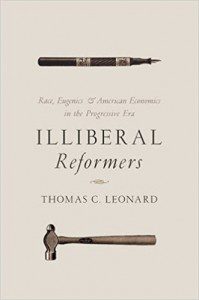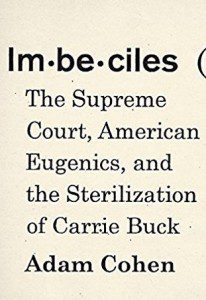(This post is a follow-up to my post from yesterday on “Eugenics, Then & Now: Immigration, Health Care, & Illiberal Progressives.”)
The supporters of the eugenics movement were primarily “progressives, intellectuals, and professionals” who strongly believed in both Darwinian Evolution and the power of modern science to reshape society for the better (Cohen 71). Without getting into all the intricacies of genetic engineering, one vital distinction is whether one is making this choice for oneself or whether someone else—such as the government—is imposing it on you. To consider a map of the U.S. in 1913, the twelve states that had passed eugenic sterilization laws were an interesting collection of states: Indiana, Washington, California, Connecticut, Nevada, Iowa, New Jersey, New York, North Dakota, Michigan, Kansas, and Wisconsin (70). So-called “defective” traits that were potential targets for compulsory sterilization were “epilepsy, criminality, alcoholism, or dependency”—another word for poverty.” Their greatest target was the purportedly ‘feebleminded’” (6). Some of those state laws began to be struck down on “equal protection” or “due process” grounds, which is one reason the Supreme Court’s 1927 decision of Buck v. Bell was so tragic; it reversed those trends (100, 121).
From his elite Boston Brahim perspective, Oliver Wendell Holmes, Jr. looked down on Carrie Buck, her mother, and her daughter, and judged them with the infamous sentence that, “Three generations of imbeciles are enough.” The truth is that Carrie Buck’s family, on her father’s side, had owned both property and people who were enslaved before the Civil War, but their family had been on a downward economic trajectory since the war’s end (19-20).
The story Carrie’s foster parents told about her is that she became pregnant at seventeen because her alleged feeblemindedness led to loose morals (16). Carrie’s side of the story, which she was never given the chance to tell in court, was that her foster mother’s nephew forced himself on her. By institutionalizing Carrie, it seems that the family sought to protect their nephew’s crime from being discovered (24). Both Carrie and her mother before her were deemed to be feebleminded by the Binet-Simon test, which it turns out was never intended for such a use (30, 34). Carrie’s daughter Vivian was even more absurdly evaluated to be feebleminded at only six months of age (95).
The truth is that Carrie did well academically and made it to the sixth grade before her foster parents forced her to quit, so that she could help more around the house (196-197). And although her daughter Vivian died tragically from a stomach infection following the measles at age eight, it turns out that Vivian’s school records show her to have been a “quite average student” and “perfectly normal” (290-291). Carrie herself died in 1983 at age 76, but many letters that she wrote still exist. They are “Neatly written and well composed.” She read the newspaper daily and enjoyed crossword puzzles (297-298). If Carrie Buck was “guilty” of anything it of being female in a sexist society, poor in a classist society, and trusting of “experts” in a system that was patriarchal, arrogant, and elitist (96).
By 1931, four years after Buck v. Bell, “twenty-eight of our nation’s forty-eight states had laws authorizing eugenic sterilization” (300). It was not until two years later in 1933 that Nazi Germany passed its Law for the Prevention of Hereditary Diseased Offspring which would be enforced by the Hereditary Health Courts. Nor did the trend stop with the U.S. and Germany: “Denmark enacted…forced sterilization of ‘mental defectives’ in 1934. Sweden and Norway also enacted sterilization laws in 1934, followed by Finland in 1935, Estonia in 1936, and Iceland in 1938” (302). Seemingly, it took the extremes of Naziism and the Holocaust to taint eugenics as unethical (Rosen 181).
That being said, Buck v. Bell has never been overturned (Cohen 217). And it is more than one of those archaic laws that remains on the books without negative impact:
In 2001, Margaret Vaughn, a young woman who had been labeled mildly mentally retarded, sued Columbia County, Missouri, for trying to force her to be sterilized. In Vaughn v. Ruoff, the U.S. Court of Appeals for the Eighth Circuit explained that ‘involuntary sterilization is not always unconstitutional…..’ As an authority…[they] cited Buck v. Bell. (318)
- More recently, the news broke in 2013 that as recently as 2010, some officials in California had been coercing female prisons to get sterilizations.
- In 2014, a former state senator in Arizona “was forced to resign” the vice-chairmanship of his political party “after he publicly called for the sterilization of women on public assistance.”
- In 2015, news broke that, “Nashville prosecutors were making sterilization part of plea negotiations with female defendants” (Cohen 320).
- And in 2016, echoes of eugenic arguments have been strongly present in debates around immigration and health care.
These issues are still with us, and will be even more so in coming decades as the science of genetic engineering continues to advance (Rosen 187).
With twenty-first century bioethics, there are legitimately messy and complex ethical quandaries. But eugenics has often been based on pseudoscience. Even before Buck v. Bell, geneticists had started to speak out (Cohen 252-253). During human reproduction, “genes combine and are expressed in complex ways.” And “intelligence, indolence, dependency, and other human qualities are not ‘unit characters’—traits passed on in a single gene from parent to child.” Said more simply, it is neither true that “brilliant parents produce brilliant children” or that “criminals produce criminals.” Rather, both genetics and reality are more complicated than that. In particular, eugenicists almost always failed to account for “demoralizing social conditions”—the ways that poverty, lack of access to education and health care are more much likely to cause negative social outcomes than genetics (Cohen 51-52).
In my tradition of Unitarian Universalism, our Fifth Source includes “guidance of reason and the results of science.” And we do seek to balance the wisdom of the world’s religious with the insights of modern science. But an equally important factor is the UU First Principle, “The inherent worth and dignity of every person”—which comes from the preamble to the U.N.’s Universal Declaration of Human Rights, passed in the wake of World War II, when we witnessed some of the worst of what we humans can do to one another.
 Unitarian Universalism is a liberal religion, from the Latin root liber, meaning “free.” And at the heart of classical liberalism is the equal right of every individual to choose how to think and how to act. And although there is the classic caveat that, “My right to swing my fist ends when it hits your nose,” involuntary sterilization is a serious invasion of an individual’s privacy and liberty. Such an act is a strong step toward totalitarianism, in which the state claims the right of total control over an individual’s body (Cohen 274). As detailed in Illiberal Reformers: Race, Eugenics, and American Economics in the Progressive Era by Thomas Leonard (Princeton University Press 2016), the challenge of eugenics in the early twentieth century is that it was progressive reformers, who perceived themselves as acting for the best interests of society, who instead acted illiberally in the name of “efficiency,” “expertise,” and “science” (Leonard 190).
Unitarian Universalism is a liberal religion, from the Latin root liber, meaning “free.” And at the heart of classical liberalism is the equal right of every individual to choose how to think and how to act. And although there is the classic caveat that, “My right to swing my fist ends when it hits your nose,” involuntary sterilization is a serious invasion of an individual’s privacy and liberty. Such an act is a strong step toward totalitarianism, in which the state claims the right of total control over an individual’s body (Cohen 274). As detailed in Illiberal Reformers: Race, Eugenics, and American Economics in the Progressive Era by Thomas Leonard (Princeton University Press 2016), the challenge of eugenics in the early twentieth century is that it was progressive reformers, who perceived themselves as acting for the best interests of society, who instead acted illiberally in the name of “efficiency,” “expertise,” and “science” (Leonard 190).
Many of these illiberal progressives saw themselves as following in the footsteps of Charles Darwin’s evolutionary biology. But a close reading of Darwin shows otherwise. In Chapter 5 of The Descent of Man, Darwin shows that he was well aware of the implications of his theory of natural selection for what later came to be called eugenics. He confesses that he can understand the temptation, but he cautions his readers that we cannot:
check our sympathy, even at the urging of hard reason, without deterioration in the noblest part of our nature. The surgeon may harden himself whilst performing an operation, for he knows that he is acting for the good of his patient; but if we were intentionally to neglect the weak and helpless, it could only be for a contingent benefit, with an overwhelming present evil. (Cohen 48, 323)
The Rev. Dr. Carl Gregg is a certified spiritual director, a D.Min. graduate of San Francisco Theological Seminary, and the minister of the Unitarian Universalist Congregation of Frederick, Maryland. Follow him on Facebook (facebook.com/carlgregg) and Twitter (@carlgregg).
Learn more about Unitarian Universalism: http://www.uua.org/beliefs/principles













